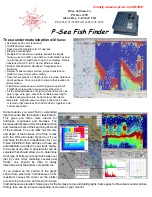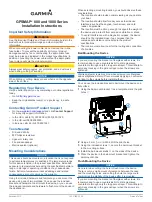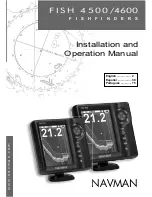
35
Operating Instructions
be broad. When using the narrower 200 kHz beam, the same fish will
produce a narrower arch.
The shape of the arch is also affected by the speed of the boat. If you are
moving slowly, the arches tend to be longer. If the boat is moving more
quickly, the arches are short and peaked. If the boat is moving very fast, a
fish may be indicated by a single vertical line.
Bottom Indications
The bottom usually produces a strong echo, so it is easy for the
FishFinder to see a lot of detail. The FishFinder can indicate many
different kinds of bottom conditions. See Fig. 3-6. A hard bottom appears
as a thin line. A softer bottom or a bottom covered with seaweed will
produce a wide line, as the sound waves reflect from different layers of the
bottom. An uneven bottom which is covered with rocks or coral produces
a complex display like that shown in the last part of the Figure. The
bottom image is irregular, with long “tails” pointing upward. A wreck
produces a similar image.
When the White Line feature is turned on, the unit can display even more
information about the bottom. In Fig. 3-4, the FishFinder is getting a good
Hard
(Sand)
Rocks
Soft
(Mud)
Fig. 3-6
Bottom
Conditions
Содержание FishFinder L265
Страница 2: ...FishFinder L265 Instruction Manual Raymarine ...
Страница 72: ...67 Maintenance andTroubleshooting ...


































